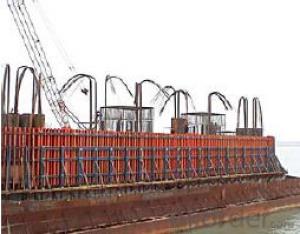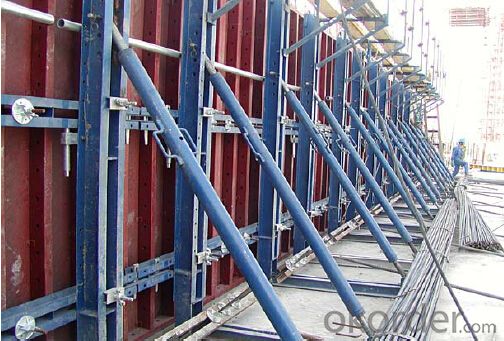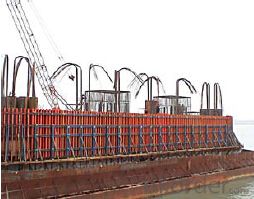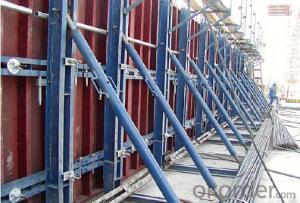Single-side Climbing Bracket SCB180 for formwork and scaffolding system
- Loading Port:
- Tianjin
- Payment Terms:
- TT OR LC
- Min Order Qty:
- 50 m²
- Supply Capability:
- 1000 m²/month
OKorder Service Pledge
OKorder Financial Service
You Might Also Like
Single-side Climbing Bracket SCB180:
With CNBM SCB 180 climbing systems, the loads from the fresh concrete pressure are transferred through the brackets by means of V-strongbacks and compression braces into the scaffold anchors.
Typical applications for the SCB 180 are dams, locks, cooling towers, pier heads, tunnels, and bank vaults.
The formwork is simply tilted backwards when striking takes place. The 1.80 m wide bracket requires only a minimum of space.
Characteristics:
◆ Economical and safe anchoring
The M30/D20 climbing cones have been designed especially for single-sided concreting using
SCB180 in dam construction, and to allow the transfer of high tensile and shear forces into the still
fresh, unreinforced concrete. Without wall-through tie-rods, finished concrete is perfect.
◆ Stable and cost-effective for high loads
generous bracket spacings allow large-area formwork units with optimal utilization of the bearing
capacity. This leads to extremely economical solutions.
◆ Simple and flexible planning
With SCB180 single-sided climbing formwork, circular structures can also be concreted without
undergoing any large planning process. Even use on inclined walls is feasible without any special
measures because additional concrete loads or lifting forces can be safely transferred into the
structure.
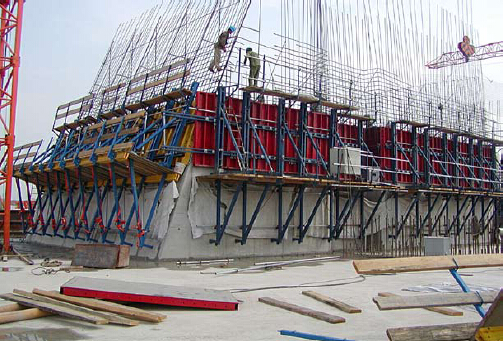
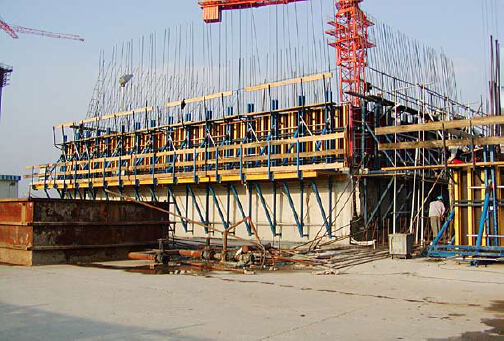
- Q: What are the different types of safety systems used with steel formwork?
- There are several types of safety systems used with steel formwork, including guardrails, safety nets, edge protection systems, fall arrest systems, and personal protective equipment (PPE). These systems are designed to prevent falls, provide barriers against hazardous areas, and protect workers from potential accidents or injuries while working with steel formwork.
- Q: What are the disadvantages of using steel formwork?
- One disadvantage of using steel formwork is its relatively high cost compared to other types of formwork materials. Additionally, steel formwork is heavy and requires special equipment for handling and installation, making it less convenient to transport and set up on construction sites. Moreover, steel formwork needs to be properly maintained to prevent rusting and corrosion, which adds to the overall maintenance cost. Lastly, steel formwork may not be suitable for complex and intricate architectural designs that require flexible formwork systems.
- Q: Can steel formwork be used for precast concrete facades with intricate patterns?
- Yes, steel formwork can be used for precast concrete facades with intricate patterns. Steel formwork is known for its strength and durability, making it suitable for creating complex and detailed designs. The flexibility of steel allows for the creation of intricate patterns, textures, and shapes on the surface of the concrete. Additionally, steel formwork can be easily adjusted and modified to accommodate any desired pattern or design. This makes it a popular choice for precast concrete facades that require intricate patterns or artistic elements. Overall, steel formwork provides the necessary support and versatility to achieve complex designs in precast concrete facades.
- Q: Can steel formwork be used for theater construction projects?
- Yes, steel formwork can be used for theater construction projects. Steel formwork refers to temporary or permanent molds made of steel that are used to shape and support concrete during the construction process. It is a versatile and durable formwork material that can be used for various construction projects, including theater construction. Steel formwork offers several advantages for theater construction projects. First, it provides a high level of strength and stability, ensuring that the concrete structures built for theaters are sturdy and long-lasting. This is particularly important in theaters, where safety is a top priority due to the large number of people that gather in these spaces. Additionally, steel formwork allows for intricate and complex designs to be achieved, which is often required in theater construction. The flexibility of steel formwork enables the creation of customized shapes, curves, and patterns, allowing architects and designers to bring their creative vision to life. Moreover, steel formwork is reusable, which makes it a cost-effective option for theater construction projects. Unlike traditional wooden formwork that needs to be replaced after a single use, steel formwork can be used multiple times, reducing material and labor costs. Lastly, steel formwork offers a faster construction process. Its ease of assembly and disassembly speeds up the construction timeline, allowing theater projects to be completed in a shorter time frame. In conclusion, steel formwork is a suitable choice for theater construction projects due to its strength, versatility, flexibility, reusability, and efficiency. It offers numerous benefits that contribute to the successful and timely completion of theater construction projects.
- Q: How does steel formwork handle different concrete reinforcement spacing?
- Steel formwork is able to handle different concrete reinforcement spacing by providing flexibility and adaptability in its design. The formwork is typically adjustable, allowing for the necessary spacing between reinforcement bars to be accommodated. This ensures that the concrete is poured and compacted around the reinforcement bars evenly, maintaining structural integrity and strength. Additionally, steel formwork is durable and strong, capable of withstanding the pressures exerted by the concrete and the reinforcement bars, regardless of their spacing.
- Q: Can steel formwork be used for concrete structures in marine environments?
- Steel formwork can be used for concrete structures in marine environments, but it requires special considerations and precautions. Marine environments, with their high levels of saltwater exposure and corrosive elements, pose unique challenges for steel formwork. The corrosive nature of the seawater can cause rapid deterioration and rusting of the steel formwork, compromising its structural integrity. To mitigate these risks, it is necessary to use high-quality corrosion-resistant steel, such as stainless steel or galvanized steel, for the formwork. These materials have better resistance to corrosion and can withstand the harsh marine environment for a longer period. Additionally, proper maintenance and regular inspection are essential to identify any signs of corrosion or damage and address them promptly. This may involve cleaning the formwork regularly, removing any accumulated salt or debris, and applying protective coatings to prevent corrosion. Furthermore, it is important to consider the design of the formwork to ensure proper drainage and minimize water exposure. Adequate provision for drainage channels and weep holes should be included to avoid the accumulation of water, which can accelerate corrosion. In conclusion, while steel formwork can be used in marine environments, it requires careful selection of corrosion-resistant materials, regular maintenance, and proper design considerations to ensure its durability and longevity. It is recommended to consult with experienced professionals and engineers who have expertise in marine construction to ensure the success of concrete structures in such environments.
- Q: Are there any maintenance requirements for steel formwork?
- Maintenance requirements exist for steel formwork. Although steel formwork is durable and long-lasting, regular maintenance is necessary to ensure proper functioning and extend its lifespan. Cleaning is one of the primary maintenance requirements for steel formwork. After each use, it is important to thoroughly clean the formwork to remove concrete residue, dirt, and debris. This can be achieved by using water and a mild detergent or specialized cleaning agents for steel surfaces. Regular cleaning prevents the accumulation of corrosive substances that can harm the formwork over time. Inspecting the steel formwork for any signs of damage or wear is also crucial. This should be done both before and after each use to identify cracks, dents, or deformities that may compromise its structural integrity. If any damages are found, prompt repairs are necessary to prevent further deterioration. Proper storage and handling of steel formwork are essential maintenance practices. After use, the formwork should be stored in a dry and well-ventilated area to prevent moisture buildup, which can cause rust and corrosion. Additionally, it should be handled with care during transportation and installation to avoid accidental damage. Applying a protective coating or paint to the steel formwork can enhance its durability and resistance to corrosion. This coating should be applied according to the manufacturer's instructions and periodically checked for any signs of deterioration. If the coating shows wear, it should be reapplied to maintain the formwork's protective properties. Regular maintenance of steel formwork not only ensures its longevity but also enhances safety on construction sites. By promptly addressing potential issues, construction projects can proceed smoothly, minimizing the risk of accidents or delays. Therefore, following recommended maintenance practices is essential to maximize the performance and lifespan of steel formwork.
- Q: Can steel formwork be used for both symmetrical and asymmetrical concrete elements?
- Yes, steel formwork can be used for both symmetrical and asymmetrical concrete elements. Steel formwork is highly versatile and can be customized to meet the specific requirements of any concrete structure, regardless of its shape or complexity. It offers the advantage of being easily adjustable, allowing for the creation of both symmetrical and asymmetrical shapes. Additionally, steel formwork provides excellent strength and durability, ensuring that it can withstand the pressure exerted by the concrete during the pouring and curing process. This makes it a suitable choice for a wide range of concrete elements, including walls, columns, beams, slabs, and more.
- Q: How does steel formwork contribute to the strength and stability of a concrete structure?
- Steel formwork is a critical component in the construction of concrete structures as it plays a crucial role in enhancing their strength and stability. One of the key ways in which steel formwork contributes to this is by providing a robust framework for the concrete to be poured into and cured. The steel formwork acts as a mold or a template that holds the liquid concrete in place until it solidifies. This ensures that the concrete takes the desired shape and form, resulting in a structurally sound and stable structure. Furthermore, steel formwork provides support and reinforcement to the concrete during the curing process. As the concrete hardens, it exerts pressure on the formwork. The high tensile strength of steel allows it to withstand and distribute these forces evenly, thereby preventing any distortion or collapse of the structure. This is particularly important in the case of large-scale or complex structures where the concrete needs to be supported over extended periods. In addition, steel formwork facilitates the proper alignment and leveling of the concrete during the construction process. The rigid nature of steel ensures that the formwork remains in place and maintains its shape, resulting in accurate dimensions and a uniform finish. This contributes to the overall strength and stability of the concrete structure by eliminating any irregularities or weaknesses that may arise from inaccuracies in the formwork. Moreover, steel formwork can be easily assembled and disassembled, allowing for efficient construction processes. This flexibility enables faster construction timelines, minimizing the exposure of the concrete to external elements and reducing the risk of structural damage. The ability to reuse steel formwork also makes it a cost-effective solution for multiple construction projects. Overall, the use of steel formwork significantly enhances the strength and stability of concrete structures by providing a sturdy framework, supporting the curing process, ensuring accurate alignment, and facilitating efficient construction practices. Its durability, strength, and versatility make it an essential component in the construction industry, contributing to the creation of safe and reliable concrete structures.
- Q: How does steel formwork impact the overall project execution?
- Steel formwork can have a significant impact on the overall project execution. Its strength and durability make it an ideal choice for construction projects, allowing for faster and more efficient work. Steel formwork also provides accurate and precise results, ensuring that the structures are built according to the desired specifications. Additionally, steel formwork is reusable, reducing the overall project costs and minimizing environmental impact. Overall, steel formwork enhances the efficiency, quality, and cost-effectiveness of the project execution.
Send your message to us
Single-side Climbing Bracket SCB180 for formwork and scaffolding system
- Loading Port:
- Tianjin
- Payment Terms:
- TT OR LC
- Min Order Qty:
- 50 m²
- Supply Capability:
- 1000 m²/month
OKorder Service Pledge
OKorder Financial Service
Similar products
Hot products
Hot Searches

